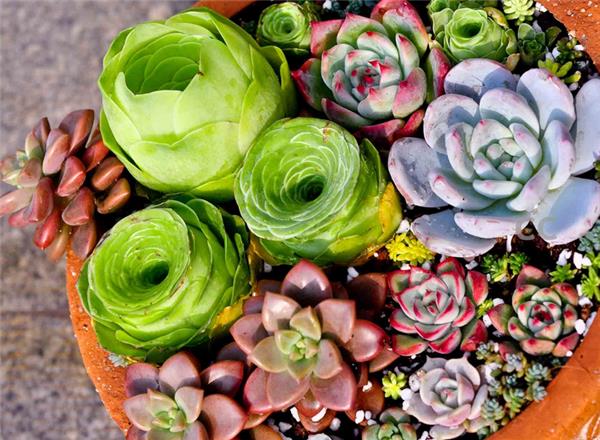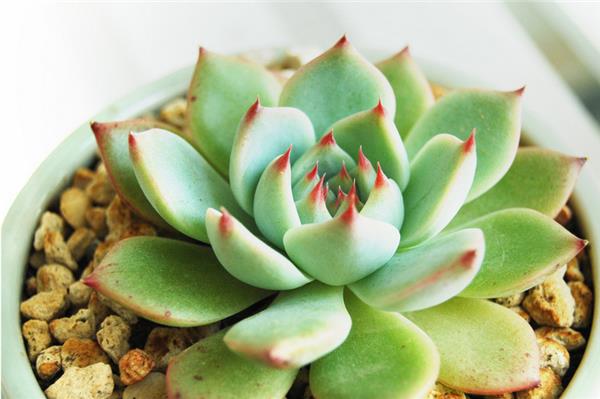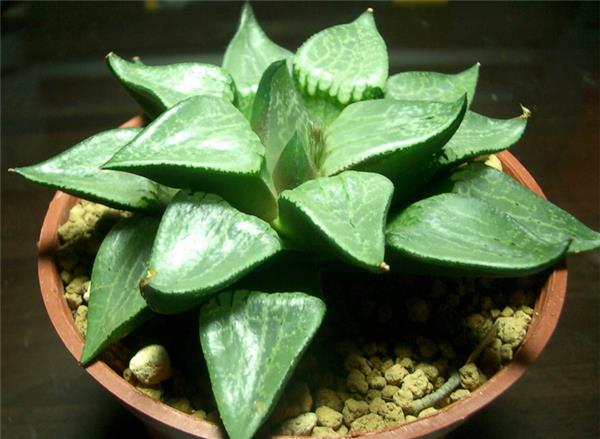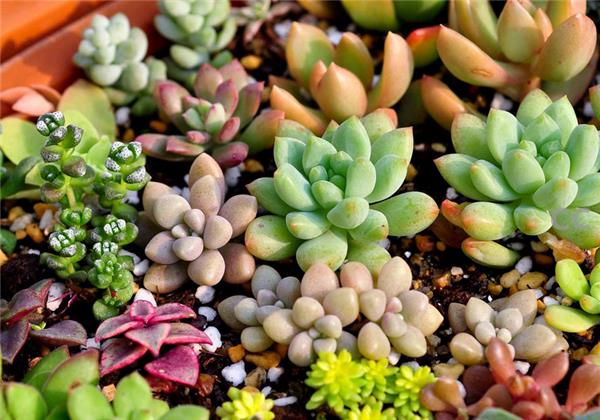What is the soil used for planting succulent plants?
In recent years, succulent plants are becoming more and more popular, but what kind of soil do you use to plant succulent plants?

What is the soil used for planting succulent plants?
Ceramsite: the characteristic is breathable, the interior has a fine pore structure, the bottom of the basin can replace the bottom stone (the succulent basin is small, generally the stone is too large to be suitable for drainage), its gap is large, it is very suitable for drainage. When mixed with other soil, it is mainly used to conserve water. The basin noodles can be used for decoration and anti-splashing. The particle size is used according to your preference, generally the bigger the bottom, the better. It has high hardness and can be reused after turning the basin.
Red jade: meat farmers all know that it is the most common succulent soil. Characteristic, expensive. The color is grayish yellow when dry, and reddish brown after absorbing water, so it is easy to judge the soil moisture. It belongs to mineral soil and is of Japanese origin. Domestic imitation is more, the use of sintering methods, the quality varies, most of them are pulverized within a year or two, including Asahi red jade exported to Japan.
Coconut bran: characteristic, pure natural, water retention and ventilation, very suitable for succulent needs. I prefer his shredded coconut, high fiber, very fast drainage, conducive to root. If it is used alone for a long time, it is easy to agglomerate, so it is recommended to be mixed with other soils. It is completely biodegradable. In addition, his performance-to-price ratio is very good.
Light stone: a kind of volcanic soil, light, blowing can fly away, characteristic, light, breathable, cheap! Personally, I think it is the best mashup raw material, small particles of light stone can completely replace perlite (this thing I hate most! ). Strong water absorption, due to the internal pores a lot of air, conducive to root breathing, the most important thing is that he pulverized very slowly! This is the main reason for the complete failure of perlite.

Germany Klasmann422 Peat: the best succulent soil, who knows who uses it. Belongs to moss peat, the fiber is moderate, almost completely tailor-made for Sedum. Features, soft, transparent, no impurities. He matches reasonably with the light stone in front of him, and eats almost all Jingtian apricot immortals. Beginners note that he does not add nutrients himself, so he has a higher degree of freedom to add fertilizers in the later stage.
Perlite: it is estimated that it was stir-fried by the owners of the greenhouse. What good is there to say about this product? It breaks as soon as it is touched, floats as soon as it is poured, and foams as a whole. The features are also cheaper. Water absorption can not absorb much, mixed soil for a long time will slowly float up! When broken, it becomes dust, which is the accomplice of soil caking. Anyway, it's just speechless.
Vermiculite: Mica-like structure, in fact, is also very easy to break, after absorbing water will expand, characteristics, water retention, very water retention. The comprehensive character is slightly better than perlite and can be used to regulate soil moisture. The quality of each vendor varies, and the difference is very great. I feel that the lighter the color is, the harder the color is, and the brown one is broken at once.
Loose scale: in fact, it is pine bark, which can absorb water, and many people also like to use it to grow tide-loving plants such as orchids. The concrete can retain moisture and is rich in nutrients, his special-shaped structure can also prevent the soil from hardening, and the meat also likes to drill into their seams. It is really a good thing to get more than one move, that is, to break up trouble. It can replace vermiculite and perlite.

Deer marsh soil: the character and usage are the same as red jade soil, lighter, but good water absorption, easy to pulverize for two years. As a soil for succulent planting, it is widely used. Like red jade soil, it is not recommended to use it alone, although many people use this alone, but its character will become worse and easy to harden over time.
Tongsheng sand: reddish volcanic stone, high iron content, very heavy, is the heaviest soil I encountered, characteristics: hard, good drainage, can lay the bottom drainage. It doesn't have any special nature, but it's so expensive.
Rice husk charcoal / rice chaff ash: drainage aeration, alkaline, usually used to mix soil pH. Features: cheap and easy to use, and rich in potassium fertilizer, a small amount of calcium and magnesium, soft texture conducive to hair roots. Molluscs such as protecting meat and snails hate this very much.
Jindalu peat granules: I like to use this very much. It has high hardness and can even be used as a slow-release fertilizer. It is rich in organic matter and humic acid and saves trouble in fertilizing. It is usually placed in the middle or bottom. Because it does not melt, it will not be hardened, and it will also benefit drainage. I can basically get some in each basin. A bag of 3.5 liters can use many pots, hehe.
Jinda green succulent soil: light stone, peat, peat, broken bark, broken brick grains, and other mixed soil, has been added fertilizer, and Asahi succulent soil belongs to the same delicate soil, but the feel is very wet, it seems that it will not dry, watering is also a headache, poor permeability, it is recommended to be mixed with other granular soil such as light stone red jade.

Jinda green orchid soil: light stone, peat, bark, vermiculite, broken brick, snake wood, and other mixed soil. Although it is orchid soil, but I think it is very suitable for succulent plants, watering goes down quickly, and the overall character is better than Jinda green succulent soil. There is a lot of bark, the soil is not easy to harden, and it also provides good grip for sturdy roots. In addition, the quality of this soil vermiculite is very good.
Plant Gold Stone: this must be washed before you can use it. There is too much dust! Dry white, after absorbing water will become good-looking golden, sprinkle surface is very good-looking! The characteristic is similar to light stone, very light, hardness is just right, will not be too hard and will not be as easy as red jade, anyway, the price is about the same. It does not contain fertilizer and needs to be added later.
Fafard sent planting No. 1 peat: like Klasmann422 peat, it belongs to moss peat, both of which are of similar properties and are excellent succulent soil. Feel that the hair of the soil is more delicate and fluffy, less impurities, but also less long fiber. Anyway, they are all made of earth, so it makes no difference. The soil from the hair is unknown with a nutritional promoter, which is better than none for succulent plants.
Germany Klasmann414 peat: compared with 422, the fiber is more and thicker. Klasmann's craft says rudely, the soil caking phenomenon is very serious, want to tear apart piece by piece, is it easy for Nima to be a farmer? Although the craft of the hair is good, it will break as soon as it is pinched, but the crude fiber of 414 is very popular, how to say, there is no perfect soil anyway!
Lei Xiuhong color stone: light stone, zeolite (green), molten rock and other mixed soil. High hardness, does not pulverize, absorbs water and breathes air, is an excellent granular succulent soil. The disadvantage is that it is too sharp! Too heavy! Can be planted directly, like mustache root meat, need to add half of the peat, I prefer this kind of high hardness succulent soil, there is no need to change the soil. Contains small round green release fertilizer, but it is best to fertilize yourself during the growing period.
Xiping succulent soil: light stone, red jade soil, volcanic stone, rice husk charcoal and other granular soil, has been added to release fertilizer, Bayer pesticides, fungicides, quite a comprehensive succulent soil, directly available. This is the succulent soil I used for the first time. At that time, I thought it was very good and breathable. I later found that the quality of the red jade soil in this product was so poor that it began to pulverize one after another after a few months.
Asahi immortal ball soil: contains light stone, peat, vermiculite, perlite, it is said that there is red jade soil, but can not be found by the naked eye, it is estimated to be broken into slag. Features, the peat inside is very fine, conducive to hair roots, but it is too powdered, feel very dry, and contains a lot of perlite, which is easy to break into powder in the process of transportation. On the whole, the particles are too powdered, so they are abandoned after using them once.
Jinda green orchid soil: light stone, peat, bark, vermiculite, broken brick, snake wood, and other mixed soil. Although it is orchid soil, but I think it is very suitable for succulent plants, watering goes down quickly, and the overall character is better than Jinda green succulent soil. There is a lot of bark, the soil is not easy to harden, and it also provides good grip for sturdy roots. In addition, the quality of this soil vermiculite is very good.
Plant Gold Stone: this must be washed before you can use it. There is too much dust! Dry white, after absorbing water will become good-looking golden, sprinkle surface is very good-looking! The characteristic is similar to light stone, very light, hardness is just right, will not be too hard and will not be as easy as red jade, anyway, the price is about the same. It does not contain fertilizer and needs to be added later.
Fafard sent planting No. 1 peat: like Klasmann422 peat, it belongs to moss peat, both of which are of similar properties and are excellent succulent soil. Feel that the hair of the soil is more delicate and fluffy, less impurities, but also less long fiber. Anyway, they are all made of earth, so it makes no difference. The soil from the hair is unknown with a nutritional promoter, which is better than none for succulent plants.
Germany Klasmann414 peat: compared with 422, the fiber is more and thicker. Klasmann's craft says rudely, the soil caking phenomenon is very serious, want to tear apart piece by piece, is it easy for Nima to be a farmer? Although the craft of the hair is good, it will break as soon as it is pinched, but the crude fiber of 414 is very popular, how to say, there is no perfect soil anyway!
Lei Xiuhong color stone: light stone, zeolite (green), molten rock and other mixed soil. High hardness, does not pulverize, absorbs water and breathes air, is an excellent granular succulent soil. The disadvantage is that it is too sharp! Too heavy! Can be planted directly, like mustache root meat, need to add half of the peat, I prefer this kind of high hardness succulent soil, there is no need to change the soil. Contains small round green release fertilizer, but it is best to fertilize yourself during the growing period.
Xiping succulent soil: light stone, red jade soil, volcanic stone, rice husk charcoal and other granular soil, has been added to release fertilizer, Bayer pesticides, fungicides, quite a comprehensive succulent soil, directly available. This is the succulent soil I used for the first time. At that time, I thought it was very good and breathable. I later found that the quality of the red jade soil in this product was so poor that it began to pulverize one after another after a few months.
Asahi immortal ball soil: contains light stone, peat, vermiculite, perlite, it is said that there is red jade soil, but can not be found by the naked eye, it is estimated to be broken into slag. Features, the peat inside is very fine, conducive to hair roots, but it is too powdered, feel very dry, and contains a lot of perlite, which is easy to break into powder in the process of transportation. On the whole, the particles are too powdered, so they are abandoned after using them once.
Related
- Wuhan Hospital Iron Tree Blooming Result Was Instantly Frightened by the Gardener Master
- Which variety of camellia is the most fragrant and best? Which one do you like best?
- What is the small blue coat, the breeding methods and matters needing attention of the succulent plant
- Dormancy time and maintenance management of succulent plants during dormancy
- Minas succulent how to raise, Minas succulent plant pictures
- What are the varieties of winter succulent plants
- How to raise succulent plants in twelve rolls? let's take a look at some experience of breeding twelve rolls.
- Attention should be paid to water control for succulent plants during dormant period (winter and summer)
- Watering experience of twelve rolls of succulent plants
- Techniques for fertilizing succulent plants. An article will let you know how to fertilize succulent plants.



